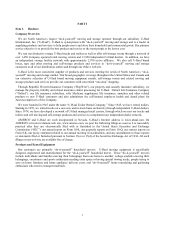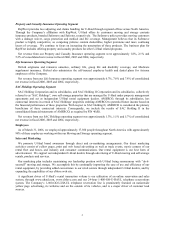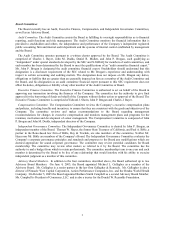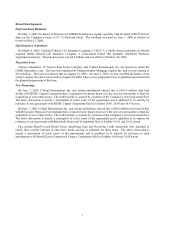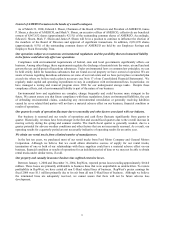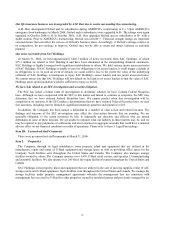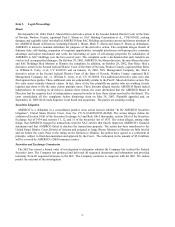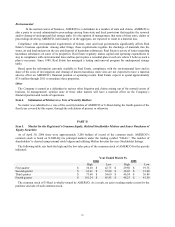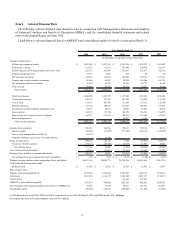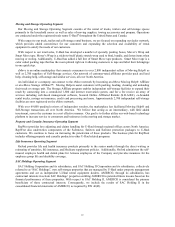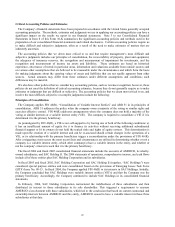U-Haul 2006 Annual Report Download - page 93
Download and view the complete annual report
Please find page 93 of the 2006 U-Haul annual report below. You can navigate through the pages in the report by either clicking on the pages listed below, or by using the keyword search tool below to find specific information within the annual report.Cautionary Statement Regarding Forward-Looking Statements
This Annual Report on Form 10-K, including the documents incorporated by reference, contains “forward-looking
statements” regarding future events and our future results. We may make additional written or oral forward-looking
statements from time to time in filings with the Securities and Exchange Commission (the “SEC”) or otherwise. We
believe such forward-looking statements are within the meaning of the safe-harbor provisions of Section 27A of the
Securities Act of 1933, as amended, and section 21E of the Securities Exchange Act of 1934, as amended. Such
statements may include, but are not limited to, projections of revenues, earnings or loss; estimates of capital
expenditures, plans for future operations, products or services; financing needs and plans; our perceptions of our
legal positions and anticipated outcomes of government investigations and pending litigation against us; liquidity;
goals and strategies; plans for new business; growth rate assumptions, pricing, costs, and access to capital and
leasing markets as well as assumptions relating to the foregoing. The words “believe”, “expect”, “anticipate”,
“estimate”, “project” and similar expressions identify forward-looking statements, which speak only as of the date
the statement was made. Forward-looking statements are inherently subject to risks and uncertainties, some of which
cannot be predicted or quantified. Factors that could significantly affect results include, without limitation, the risk
factors enumerated at the end of this section, as well as the following: the Company’ s ability to operate pursuant to
the terms of its credit facilities; the Company’ s ability to maintain contracts that are critical to its operations; the
costs and availability of financing; the Company’ s ability to execute its business plan; the Company’ s ability to
attract, motivate and retain key employees; general economic conditions; fluctuations in our costs to maintain and
update our fleet and facilities; our ability to refinance our debt; changes in government regulations, particularly
environmental regulations; our credit ratings; the availability of credit; changes in demand for our products; changes
in the general domestic economy; the degree and nature of our competition; the resolution of pending litigation
against the Company; changes in accounting standards and other factors described in this report or the other
documents we file with the SEC. The above factors, the following disclosures, as well as other statements in this
report and in the Notes to our Consolidated Financial Statements, could contribute to or cause such differences, or
could cause our stock price to fluctuate dramatically. Consequently, the forward-looking statements should not be
regarded as representations or warranties by the Company that such matters will be realized. The Company
disclaims any intent or obligation to update or revise any of the forward-looking statements, whether in response to
new information, unforeseen events, changed circumstances or otherwise.
Item 1A.
Risk Factors
The following discussion of risk factors should be read in conjunction with Management’ s Discussion and
Analysis of Financial Condition and Results of Operations (MD&A), the consolidated financial statements and
related notes. These risk factors may be important in understanding this Annual Report on Form 10-K or elsewhere.
We operate in a highly competitive industry.
The truck rental industry is highly competitive and includes a number of significant national, regional and local
competitors. Competition is generally based on convenience of rental locations, availability of quality rental moving
equipment, breadth of essential services and price. In our truck rental business, our primary competitors are Budget
Car and Truck Rental Company and Penske Truck Leasing. Some of our competitors may have greater financial
resources than we have. We can not assure you that we will be able to maintain existing rental prices or implement
price increases.
The self-storage industry is large and highly fragmented. We believe the principle competitive factors in this
industry are convenience of storage rental locations, cleanliness, security and price. Some of our primary
competitors in the self-storage market are Public Storage, Inc., Extra Space Storage, Inc., and Sovran Self-Storage
Inc. Competition in the market areas in which we operate is significant and affects the occupancy levels, rental sales
and operating expenses of our facilities. Competition might cause us to experience a decrease in occupancy levels,
limit our ability to raise rental sales and require us to offer discounted rates that would have a material affect on
operating results.
Entry into the self-storage business through acquisition of existing facilities is possible for persons or institutions
with the required initial capital. Development of new self-storage facilities is more difficult however, due to zoning,
environmental and other regulatory requirements. The self-storage industry has in the past experienced overbuilding
in response to perceived increases in demand. We cannot assure you that we will be able to successfully compete in
existing markets or expand into new markets.
10




